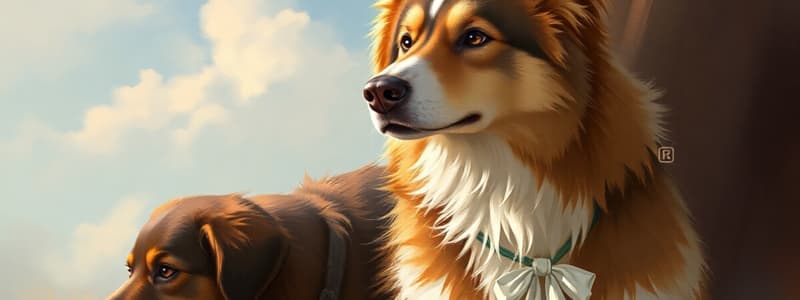Podcast
Questions and Answers
How often do bitches typically come into season?
How often do bitches typically come into season?
- Every 6 months (correct)
- Every 4 months
- Every year
- Every 3 months
The gestation period of a bitch is approximately 63 days.
The gestation period of a bitch is approximately 63 days.
True (A)
At what age do puppies typically begin the weaning process?
At what age do puppies typically begin the weaning process?
3 to 4 weeks
Dogs are classified into _____ breed groups.
Dogs are classified into _____ breed groups.
Match the dog breed groups with their original purpose:
Match the dog breed groups with their original purpose:
What is the average litter size for a domestic dog?
What is the average litter size for a domestic dog?
Domestic dogs do not follow the hunting pattern of wild dogs.
Domestic dogs do not follow the hunting pattern of wild dogs.
How often do bitches usually come into heat?
How often do bitches usually come into heat?
The gestation period for a domestic dog is _____ days.
The gestation period for a domestic dog is _____ days.
Match the following types of veterinary care with their descriptions:
Match the following types of veterinary care with their descriptions:
Which of the following dog breeds is categorized as a scent hound?
Which of the following dog breeds is categorized as a scent hound?
All toy breeds require a significant amount of exercise.
All toy breeds require a significant amount of exercise.
Name one breed that belongs to the retriever category.
Name one breed that belongs to the retriever category.
The term 'utility' in dog breed groups refers to breeds that are fit for a specific _______.
The term 'utility' in dog breed groups refers to breeds that are fit for a specific _______.
Match the dog breed groups with their primary characteristics:
Match the dog breed groups with their primary characteristics:
Which dog breed is commonly associated with herding cloven-footed animals?
Which dog breed is commonly associated with herding cloven-footed animals?
Canine obesity is a concern in developed countries with many dogs being overweight.
Canine obesity is a concern in developed countries with many dogs being overweight.
What is one common characteristic of the toy breed group?
What is one common characteristic of the toy breed group?
The _______ breed group consists of dogs that were bred to perform specific functions not included in sporting or working categories.
The _______ breed group consists of dogs that were bred to perform specific functions not included in sporting or working categories.
What breed is an example of a dog in the working group?
What breed is an example of a dog in the working group?
Flashcards
Socialization Period
Socialization Period
The period from birth to 16 weeks where a puppy learns crucial social skills, like getting used to noises, people, and other dogs.
Weaning
Weaning
The process of gradually transitioning a puppy from mother's milk to solid food.
Season (for a bitch)
Season (for a bitch)
A dog's reproductive cycle, typically occurring every 6 months.
Gestation Period
Gestation Period
Signup and view all the flashcards
Puppy Food
Puppy Food
Signup and view all the flashcards
Gun Dog
Gun Dog
Signup and view all the flashcards
Hound
Hound
Signup and view all the flashcards
Pastoral Dog
Pastoral Dog
Signup and view all the flashcards
Terrier
Terrier
Signup and view all the flashcards
Toy Dog
Toy Dog
Signup and view all the flashcards
Utility Dog
Utility Dog
Signup and view all the flashcards
Working Dog
Working Dog
Signup and view all the flashcards
Dog Husbandry
Dog Husbandry
Signup and view all the flashcards
Dog Diet
Dog Diet
Signup and view all the flashcards
Canine Obesity
Canine Obesity
Signup and view all the flashcards
Body Condition Score 17
Body Condition Score 17
Signup and view all the flashcards
Dog Feeding: Pack Instinct
Dog Feeding: Pack Instinct
Signup and view all the flashcards
Senior Dog Feeding
Senior Dog Feeding
Signup and view all the flashcards
Dog's Daily Routine
Dog's Daily Routine
Signup and view all the flashcards
Routine Veterinary Care for Dogs
Routine Veterinary Care for Dogs
Signup and view all the flashcards
Pre-Breeding Veterinary Check-up
Pre-Breeding Veterinary Check-up
Signup and view all the flashcards
Bitch's Heat Cycle
Bitch's Heat Cycle
Signup and view all the flashcards
Dog Mating: The Tie
Dog Mating: The Tie
Signup and view all the flashcards
Study Notes
Dog Husbandry Learning Outcomes
- Define dog breed groups and give examples of breeds within each group.
- Describe dog husbandry requirements, including diet, behaviour, and welfare.
- Describe dog breeding practices and pup care.
Dog Breeds
- Dog breeds are organized into groups.
- The Kennel Club recognizes 7 groups: Terrier, Gun, Hound, Pastoral, Working, Utility, and Toy (plus dangerous dog breeds).
Gun Dogs
- Originally trained for finding and retrieving game.
- Four categories: Retrievers, Spaniels, Hunt/point/retrieve, Pointers/Setters.
- Good companions, suitable for families.
- Require a fair amount of exercise.
Hound Dogs
- Originally hunted by scent or sight.
- Scent hounds (beagles, bloodhounds) and sight hounds (greyhounds).
- Many require a significant amount of exercise, though some do not.
Pastoral Dogs
- Herding dogs associated with livestock (cattle, sheep, reindeer).
- Usually have a weatherproof double coat for working in severe weather.
- Examples include Border Collies and German Shepherds.
Terrier Dogs
- Bred for hunting vermin.
- Named after the Latin word "terra" meaning earth.
- Hardy, brave, and tough dogs that hunt both above and below ground.
- Examples include Welsh Terrier, Border Terrier
Toy Dogs
- Small companion or lap dogs.
- Many were bred for their size, others placed in this category.
- Usually friendly and enjoy attention.
- Do not need a large amount of exercise; can be finicky eaters.
- Examples include Bichon Frisé, Yorkshire Terrier, Cavalier King Charles Spaniel
Utility Dogs
- Miscellaneous breeds of dog, mostly non-sporting.
- Perform specific tasks not included in sporting or working categories.
- Includes dogs like Standard Poodles and Bulldogs.
Working Dogs
- Bred to be guards and search/rescue dogs.
- Examples include Rottweilers and Bernese Mountain Dogs.
Dog Diet
- Dogs are omnivores, members of the Carnivora order, Canidae family.
- Commercial foods (wet/dry) and home-prepared options are common.
- Raw food is also available.
- Always provide fresh water.
Canine Obesity
- Almost two-thirds of dogs in developed countries are overweight.
- Excessive feeding of treats, cake, chocolate, biscuits, crisps, chips, takeaway, and table scraps contributes.
- Obesity predisposes to cancer, diabetes, heart disease, and joint issues like arthritis.
Body Condition Score (BCS)
- Dogs are scored from 1-9 (1-3 underweight; 4-5 ideal; 6-9 overweight/obese).
- Assess ribs and tail base coverage to estimate body fat.
- Use side and overhead views to look for abdominal tuck and waist.
Feeding Dogs
- Adult wild dogs hunt in packs, eating quickly and resting afterward.
- Domestic dogs typically eat once or twice a day.
- Senior dogs have reduced activity and lower basal metabolic rate (BMR).
Activity and Behaviour
- Dogs spend around 50% of the day sleeping, 30% resting, and 20% in activity.
- Physical and mental exercise needs depend on breed, individual age, and health.
- Dogs need social interaction in packs, depending on each other for survival.
Routine Veterinary Care
- Parasite control (fleas, ticks, worms, lungworm) - vary by region.
- Vaccinations (Leptospira, Adenovirus, Distemper, Parvovirus, Parainfluenza, Bordetella, Rabies).
- Grooming (at home or by groomers) – varies with breed.
Travelling in Cars
- 48% of UK dog owners break highway code by not restraining dogs.
- Restraint is essential for safety, avoiding accidents.
Canine Breeding
- Before breeding, a vet check, up-to-date vaccinations, and worming are necessary.
- Bitches usually come into heat every 6 months (can vary).
- The bitch should be at least one year old and preferably have had a normal season prior to mating.
Canine Mating
- Canine mating is a multi-stage process.
- Stages include the first stage of coitus (1-2 minutes), the turn (2-5 seconds), and the second stage of coitus (5–45 minutes).
Canine Breeding - Whelping
- Gestation period typically lasts 63 days.
- Average litter size is around 6 pups (can be more).
- Pre-whelping prep involves introducing the whelping box.
- Stages of whelping: contractions, delivery of the puppy, and delivery of the placenta.
- Normal time frame: 2-24 hours from start to finish.
- Discharge may be clear, red or green.
- Dystocia (difficult delivery) more common in brachycephalic breeds
Canine Breeding - Care of Newborn Puppies
- Puppies are born with ears and eyes closed. Eyes open in ~10 days, ears in ~14 days.
- Handle them as little as possible in the first 3 weeks.
- Environmental temperature is crucial:
- Day 1: 32°C
- Day 5: 29.5°C
- Day 7-10: 26.5°C
- End of Week 4: 22°C
Nutrition During Pregnancy and Lactation
- First 5-6 weeks of gestation have small increases in nutrient needs.
- Requirements increase in the last 3-4 weeks of pregnancy and lactation.
- Feed small, frequent meals of concentrated diets (puppy food).
Weaning and Growth
- Weaning begins at 3-4 weeks of age using commercial weaning foods in small amounts.
- Puppies are fully weaned by 8 weeks.
- High demand for energy, proteins, vitamins, and minerals, so balancing diets is critical.
- Feed frequently initially, reducing frequency as maturity approaches.
- Maturity varies based on breed (Toy: 6-9 months; Giant: 16-18 months).
Dog Training
- Socialization period (birth to 16 weeks) is crucial for future behavior.
- Training includes getting used to household noises, going out in public, and meeting new people and other dogs.
- Training can continue throughout.
Summary
- There are 7 dog breed groups.
- Dogs are omnivores and hunt in packs in the wild.
- Bitches come into season approximately every 6 months.
- Gestation lasts about 63 days.
- Bitches should be fed puppy food from around week 3 of pregnancy.
- Weaning occurs at 3-4 weeks and is typically complete by week 8.
- The socialization period in puppies is very important.
Studying That Suits You
Use AI to generate personalized quizzes and flashcards to suit your learning preferences.




